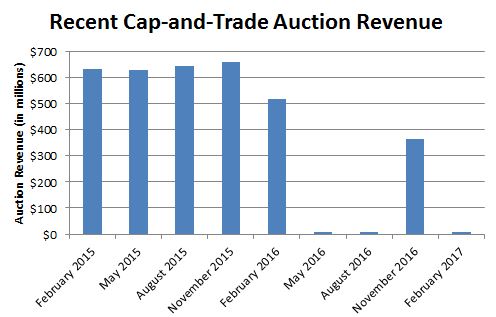Auction Generates About $8 Million in State Revenue. The Air Resources Board (ARB) released a summary of the results from the most recent quarterly cap-and-trade auction held on February 22, 2017. Based on the preliminary results, the state will likely generate about $8 million in revenue from the auction. As shown in the figure below, this amount is substantially less than what the state received from the last auction in November 2016 ($364 million), but similar to May 2016 and August 2016 auctions ($10 million and $8 million, respectively). About 17 percent of the total number of allowances offered for sale were purchased—including allowances owned by California utilities and Quebec. Allowances were purchased at the minimum price established by ARB—$13.57.
Several Factors Likely Contribute to Revenue Uncertainty and Volatility. There continues to be significant short-term and long-term uncertainty about cap-and-trade auction revenue. As we noted in prior blog posts and our February budget report, there are likely several different factors that contributed to the low demand for allowances in recent auctions, including (1) an oversupply of allowances, (2) uncertainty related to an ongoing court case challenging the legality of state-auctioned allowances, and (3) uncertainty about whether ARB has legal authority to continue cap-and-trade beyond 2020. These continue to be important factors affecting long-term market conditions and state revenue.
The short-term increased bidding activity and state revenue at the November 2016 auction could have been related to the annual increase in the minimum price—from $12.73 to $13.57—that went into effect for the February 2017 auction. It is possible that this price increase resulted in somewhat higher demand for allowances at the November 2016 auction—the last one before the price increase—thereby producing a short-term increase in the amount of revenue generated at that auction.
Implications for Cap-and-Trade Budget. The Governor’s 2017-18 budget proposes a $2.2 billion cap-and-trade expenditure plan, $1.3 billion of which is contingent on the Legislature extending ARB’s authority to operate cap-and-trade beyond 2020 with a two-thirds vote. The Governor’s budget assumes $1 billion in cap-and-trade revenue in 2016-17 and $1.5 billion in 2017-18. In total, the first three quarterly auctions of 2016-17 have generated about $380 million—which is tracking well below the Governor’s budget assumptions. Results from the May 2017 auction will be available by June and provide some additional revenue clarity before the Legislature adopts a budget for 2017‑18. However, estimates of 2017‑18 revenue will continue to be subject to substantial uncertainty.
Actions by the courts or the Legislature that provide legal clarity about the future of the program could have significant effects on future auction revenue. For example, the Legislature extending the program with a two‑thirds vote would provide greater certainty that the program would exist beyond 2020. If the cap is expected to limit emissions beyond 2020, a statutory extension of the program would very likely increase demand for allowances and state revenue.
For more details on the Governor’s 2017-18 budget proposal and our recommendations to the Legislature, see our February report The 2017-18 Budget: Cap-and-Trade.
Follow @LAOEconTax on Twitter for regular California economy and tax updates.

